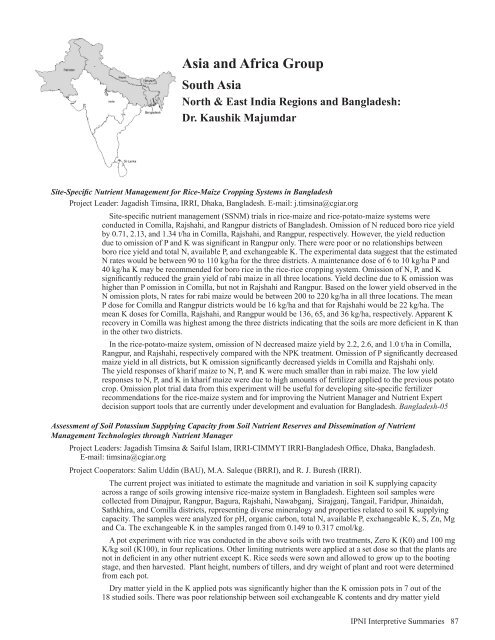Americas and Oceania Group - International Plant Nutrition Institute
Americas and Oceania Group - International Plant Nutrition Institute
Americas and Oceania Group - International Plant Nutrition Institute
You also want an ePaper? Increase the reach of your titles
YUMPU automatically turns print PDFs into web optimized ePapers that Google loves.
Asia <strong>and</strong> Africa <strong>Group</strong><br />
South Asia<br />
North & East India Regions <strong>and</strong> Bangladesh:<br />
Dr. Kaushik Majumdar<br />
Site-Specific Nutrient Management for Rice-Maize Cropping Systems in Bangladesh<br />
Project Leader: Jagadish Timsina, IRRI, Dhaka, Bangladesh. E-mail: j.timsina@cgiar.org<br />
Site-specific nutrient management (SSNM) trials in rice-maize <strong>and</strong> rice-potato-maize systems were<br />
conducted in Comilla, Rajshahi, <strong>and</strong> Rangpur districts of Bangladesh. Omission of N reduced boro rice yield<br />
by 0.71, 2.13, <strong>and</strong> 1.34 t/ha in Comilla, Rajshahi, <strong>and</strong> Rangpur, respectively. However, the yield reduction<br />
due to omission of P <strong>and</strong> K was significant in Rangpur only. There were poor or no relationships between<br />
boro rice yield <strong>and</strong> total N, available P, <strong>and</strong> exchangeable K. The experimental data suggest that the estimated<br />
N rates would be between 90 to 110 kg/ha for the three districts. A maintenance dose of 6 to 10 kg/ha P <strong>and</strong><br />
40 kg/ha K may be recommended for boro rice in the rice-rice cropping system. Omission of N, P, <strong>and</strong> K<br />
significantly reduced the grain yield of rabi maize in all three locations. Yield decline due to K omission was<br />
higher than P omission in Comilla, but not in Rajshahi <strong>and</strong> Rangpur. Based on the lower yield observed in the<br />
N omission plots, N rates for rabi maize would be between 200 to 220 kg/ha in all three locations. The mean<br />
P dose for Comilla <strong>and</strong> Rangpur districts would be 16 kg/ha <strong>and</strong> that for Rajshahi would be 22 kg/ha. The<br />
mean K doses for Comilla, Rajshahi, <strong>and</strong> Rangpur would be 136, 65, <strong>and</strong> 36 kg/ha, respectively. Apparent K<br />
recovery in Comilla was highest among the three districts indicating that the soils are more deficient in K than<br />
in the other two districts.<br />
In the rice-potato-maize system, omission of N decreased maize yield by 2.2, 2.6, <strong>and</strong> 1.0 t/ha in Comilla,<br />
Rangpur, <strong>and</strong> Rajshahi, respectively compared with the NPK treatment. Omission of P significantly decreased<br />
maize yield in all districts, but K omission significantly decreased yields in Comilla <strong>and</strong> Rajshahi only.<br />
The yield responses of kharif maize to N, P, <strong>and</strong> K were much smaller than in rabi maize. The low yield<br />
responses to N, P, <strong>and</strong> K in kharif maize were due to high amounts of fertilizer applied to the previous potato<br />
crop. Omission plot trial data from this experiment will be useful for developing site-specific fertilizer<br />
recommendations for the rice-maize system <strong>and</strong> for improving the Nutrient Manager <strong>and</strong> Nutrient Expert<br />
decision support tools that are currently under development <strong>and</strong> evaluation for Bangladesh. Bangladesh-05<br />
Assessment of Soil Potassium Supplying Capacity from Soil Nutrient Reserves <strong>and</strong> Dissemination of Nutrient<br />
Management Technologies through Nutrient Manager<br />
Project Leaders: Jagadish Timsina & Saiful Islam, IRRI-CIMMYT IRRI-Bangladesh Office, Dhaka, Bangladesh.<br />
E-mail: timsina@cgiar.org<br />
Project Cooperators: Salim Uddin (BAU), M.A. Saleque (BRRI), <strong>and</strong> R. J. Buresh (IRRI).<br />
The current project was initiated to estimate the magnitude <strong>and</strong> variation in soil K supplying capacity<br />
across a range of soils growing intensive rice-maize system in Bangladesh. Eighteen soil samples were<br />
collected from Dinajpur, Rangpur, Bagura, Rajshahi, Nawabganj, Sirajganj, Tangail, Faridpur, Jhinaidah,<br />
Sathkhira, <strong>and</strong> Comilla districts, representing diverse mineralogy <strong>and</strong> properties related to soil K supplying<br />
capacity. The samples were analyzed for pH, organic carbon, total N, available P, exchangeable K, S, Zn, Mg<br />
<strong>and</strong> Ca. The exchangeable K in the samples ranged from 0.149 to 0.317 cmol/kg.<br />
A pot experiment with rice was conducted in the above soils with two treatments, Zero K (K0) <strong>and</strong> 100 mg<br />
K/kg soil (K100), in four replications. Other limiting nutrients were applied at a set dose so that the plants are<br />
not in deficient in any other nutrient except K. Rice seeds were sown <strong>and</strong> allowed to grow up to the booting<br />
stage, <strong>and</strong> then harvested. <strong>Plant</strong> height, numbers of tillers, <strong>and</strong> dry weight of plant <strong>and</strong> root were determined<br />
from each pot.<br />
Dry matter yield in the K applied pots was significantly higher than the K omission pots in 7 out of the<br />
18 studied soils. There was poor relationship between soil exchangeable K contents <strong>and</strong> dry matter yield<br />
IPNI Interpretive Summaries 87

















